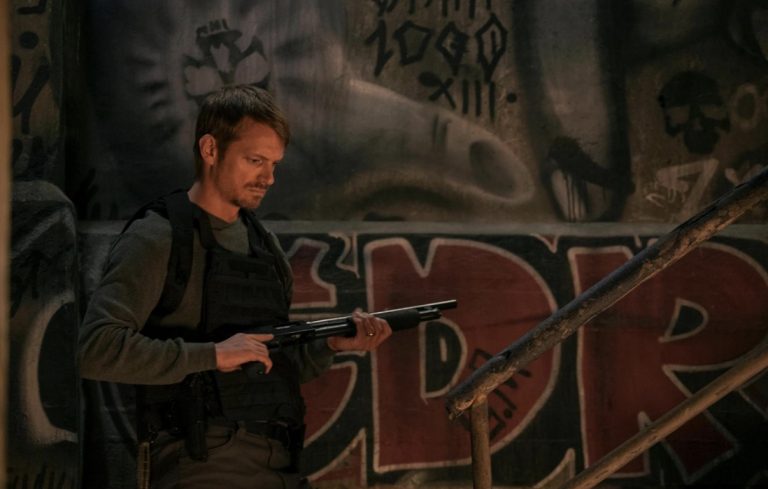John Woo’s heart-pounding Silent Night has no cheerful Santas or carol singers. There is no conversation in the holiday action to break up the story or the battle scenes, and Joel Kinnaman, who plays the lead in the film For All Mankind, says that this didn’t bother him. The script became irrelevant when he learned he would be working with Woo.
Story Stages
So how did Silent Night pull off a dialogue-free, nearly two-hour film?
The movie’s premise is that on Christmas Eve while playing in their yard, a father (Kinnaman) and his kid (Anthony Giulietti) become caught in the crossfire of a gang. Unfortunately, the young child dies, and Kinnaman’s character is rendered speechless by his injuries. Silent Night is produced by the same people who brought us John Wick, stars Harold Torres, Catalina Sandino Moreno, and Kid Cudi. It immediately turns dark, becoming an action-packed revenge thriller directed by a genre pioneer.
Kinnaman discusses the difficulties of filming a dialogue-free movie and how he had to change his acting style to make it work. Stunts became the film’s focal point under Woo’s direction to maintain the story’s momentum.
Recounting His Collaboration with John Woo
Engaging in a conversation centered on his collaboration with legendary director John Woo, enthusiastic about the experience, Kinnaman reflected on the initial surreal encounter. Expressing his reverence, he reminisced, “It was a dream come true.” The opportunity arose following a discussion with producers Basil Iwanyk and Erica Lee, who posted their shared project. A proposition emerged: a film under Woo’s helm without spoken lines. This unconventional proposition was instantly gripping for Kinnaman, prompting an immediate commitment.
However, the unconventional nature of the project posed a unique challenge for Kinnaman as an actor. Addressing the absence of dialogue, he revealed the unexpected intensity of emoting solely through facial expressions and gestures. Contrary to the belief that the absence of lines might simplify the process, Kinnaman discovered that it demanded higher emotional readiness.
Typically, dialogue serves as an anchor, facilitating emotional immersion into scenes and aiding storytelling. Devoid of this verbal crutch, Kinnaman is deeply engaged with intense emotions of rage, sadness, and fiery hatred, essential to the film’s narrative trajectory. This unconventional approach significantly amplified the emotional demands on his performances.
Preparation and Rigor of ‘Silent Night’ Stunts
Transitioning to the challenges posed by stunt sequences in ‘Silent Night,’ Kinnaman revealed the physical and logistical hurdles faced during the shoot. The anticipation of the stair sequence’s rigors loomed large in his mind. Shot in Mexico City at an elevated altitude, running upstairs became an arduous task, doubling the physical exertion. His initial attempt left him stunned, realizing the formidable physicality demanded by the scene.
Further, the filming location, an unfinished or semi-demolished parking lot building, posed risks. The discovery of potential hazards, like significant drops or hazardous protrusions, led the crew to ensure safety meticulously. Kinnaman highlighted the strenuous efforts undertaken by the stunt team, executing perilous falls in narrow staircases, with potential falls of 15 to 20 feet heightening the risks. The slightest misalignment during a fall could result in severe injuries, emphasizing the dedication and rigor of executing these demanding stunts.
John Woo’s Cinematic Experimentation
For celebrated filmmaker John Woo, each cinematic endeavor represents an innovative experiment. In discussing his latest film, “Silent Night,” Woo revealed how this project pushed the boundaries of storytelling by relying solely on visual narratives. “Silent Night is a new kind of experiment for me because I had to find a way to use purely visuals to tell a story,” Woo explained. “I had to let the audience work out and understand what’s going on and how to feel.”
To accomplish this, meticulous and specialized techniques were employed. Woo elaborated on the challenges of engaging the audience with characters and themes while emphasizing the reliance on instinctual direction. “I shot everything based on my feelings, but I still looked at it as a normal drama,” Woo remarked. “I wouldn’t worry about potential mistakes; I trusted my technique and belief as a skilled visual storyteller.” Additionally, Woo expressed his confidence in the cast, especially Joel Kinnaman, Scott Mescudi, Harold Torres, and Catalina Sandino Moreno, applauding their quick comprehension of the film’s creative vision.
Interestingly, despite the absence of spoken dialogue, the script for “Silent Night” maintained a substantial length, exceeding 100 pages. Woo highlighted the script’s comprehensive detail and descriptions, acknowledging the inclusion of pivotal dialogue within the descriptions to guide the actors. “Even though there were no words for the actors, the writer included key dialogue in the descriptions as a guide,” Woo explained. “It was just a lot of key information.”
Given “Silent Night’s” action-packed holiday setting, natural comparisons arise with classic films like Die Hard and Lethal Weapon. However, Woo clarified that while the film shares similar holiday settings, he didn’t draw direct inspiration from these classics. He also noted a significant difference: unlike “Silent Night,” none of these films were released in theaters during the holiday season.
